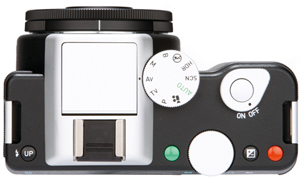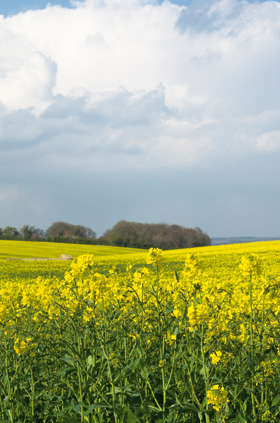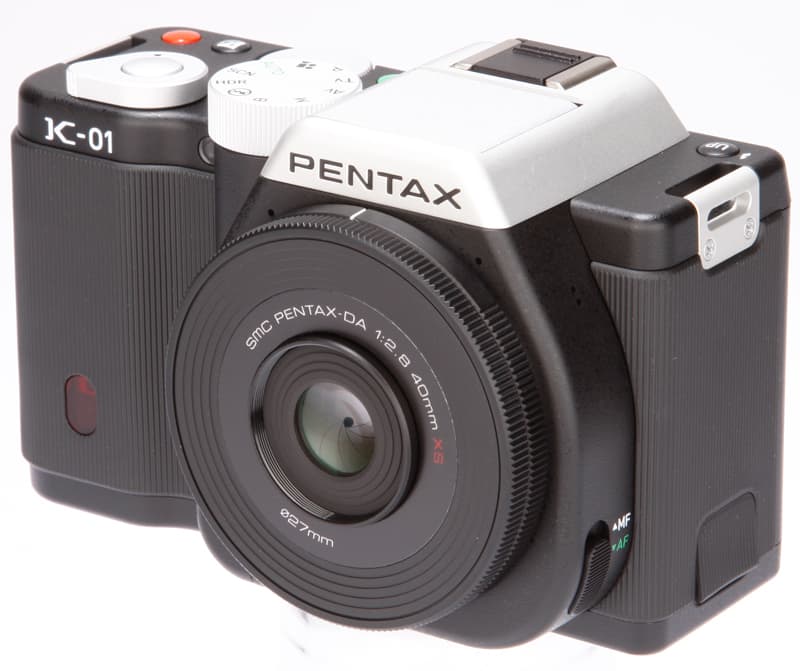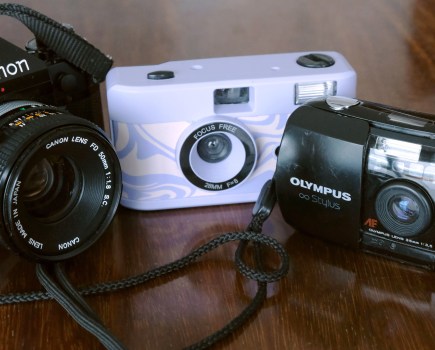At a glance:
- 16.28-million-pixel CMOS sensor
- Pentax K mount
- 3in, 921,000-dot
- LCD screen
- ISO 100-25,600
- Built-in flash
- Street price around £600 (body only), around £680 (with 40mm f/2.8 XS pancake lens)
When digital cameras first became popular, people were saying that reflex mechanisms, mirrors, prisms and viewfinders could all disappear. With these traditional pieces of engineering gone, cameras would no longer have to look the way they always had so they could be all sorts of new shapes and sizes.
Most manufacturers now have a compact system camera range that foregoes traditional SLR technology, with LCD screens and EVFs replacing optical viewfinders. By removing the mirror box, new mounts can be created to make interchangeable lenses smaller and lighter. But what if you kept an existing mount and designed a digital camera that had no optical viewfinder? That is just what Pentax has done with the K-01.
Designed by Australian designer Marc Newson, the K-01 is a mirrorless system camera that uses Pentax’s standard K lens mount. At its launch, it was the K-01’s simple yet striking looks that drew most attention. Yet while the K-01 is unconventional when compared to its contemporaries, its core is built entirely around Pentax’s DSLR range.
In this test I want to find out how the K-01’s unique design works in practice, and whether there are any advantages to removing the reflex mirror and viewfinder.
Features

The K-01’s 16.28-million-pixel, APS-C-sized (23.7×15.7mm) CMOS sensor has been used a number of times in the past, in various different guises. It is the same sensor as that found in the Pentax K-5 and, being a Sony-made unit, it is also present in the Alpha 55, Alpha 57 and NEX-5N, as well as in the Nikon D7000.
This sensor has performed extremely well in all these cameras, particularly in low light, producing minimal noise, a good dynamic range and excellent recovery of shadow detail.
Removing the reflex mechanism from a camera has a significant impact on its design and performance. With the K-01, the most obvious change is the lack of an optical viewfinder yet no option for fitting an electronic viewfinder, but more on this later. There is also no phase-detection AF system, so like most compact system cameras the K-01 relies on contrast detection.
The range of metering and exposure modes available on the K-01 will be familiar to DSLR users, as this camera has a full complement of manual exposure modes and a variety of scene options. Evaluative, centreweighted and spot metering modes are on hand to help photographers get a correctly exposed image.
As the electronics of the camera are similar to those of the K-5, most of the capabilities of that camera are also present in the K-01. The new camera shoots both raw and JPEG images, has built-in image stabilisation, a multi-exposure mode, interval timer and HDR capture mode.
The K mount, around which the K-01 is designed, has been used in Pentax SLR cameras since 1975, so there are hundreds of different lenses that are available for use with the K-01 and, for that matter, the company’s current DSLR range. This should be one of the biggest selling points for the K-01, as many photographers will have old Pentax lenses lurking in cupboards waiting to be given a new lease of life.
The firm’s current range of AF lenses is also very comprehensive, and Pentax has even created a new optic to complement the K-01 – an unbelievably thin 40mm f/2.8 pancake lens.
SMC Pentax-DA 40mm f/2.8 XS lens

Complementing the Pentax K-01 is the 40mm f/2.8 pancake lens. It is staggeringly thin, and when mounted on the camera is not much thicker than a standard body cap. Pentax claims that, at the time of introduction, it is the world’s ‘thinnest interchangeable lens’.
In fact, it is just 9.2mm deep, not including the mount that protrudes into the camera body. It is also light, weighing just 52g, and it can be carried around in a pocket.
Impressively for a lens as thin as this, the Pentax pancake optic comprises five elements in four groups and has an f/2.8 aperture.
With a 61mm equivalent focal length, it is ideal for travel, street and portrait images, and the f/2.8 aperture makes it useful in low light.
With such a thin lens there is no manual aperture control ring, although manual focusing is possible with a very thin focusing barrel.
Marc Newson has also designed this 40mm f/2.8 pancake lens, so it has the same minimalist styling as the K-01. The pair complement each other rather well, although it is strange to see such a thin lens on what is, comparably, quite a substantial body.
 Optically, the lens is very good, almost matching the resolution chart images taken with the Pentax 16-50mm f/2.8 optic. This pancake lens is also sharp at the edges, and while there is the merest hint of red/cyan fringing in a couple of images, it is so faint that it is easily removed and won’t be noticeable in most photographs.
Optically, the lens is very good, almost matching the resolution chart images taken with the Pentax 16-50mm f/2.8 optic. This pancake lens is also sharp at the edges, and while there is the merest hint of red/cyan fringing in a couple of images, it is so faint that it is easily removed and won’t be noticeable in most photographs.
Resolution chart: Despite its small size, the 40mm f/2.8 lens can resolve a lot of detail. It almost matches the resolution of the 16-50mm f/2.8 optic.
Specifications
- RRP: £289.99
- Filter diameter: 27mm
- Lens elements: 5
- Groups: 4
- Diaphragm blades: 9
- Aperture: f/2.8-22
- Minimum focus: 24cm
- Length: 9.2mm
- Diameter: 62.9mm
- Weight: 52g
- Lens mount: Pentax KA
Build and handling
Before we discuss how well the K-01 handles, we should perhaps address an issue that has caused a great deal of excitement – the camera’s appearance. How a camera looks is an entirely subjective issue, so I can only offer my personal opinion. To me, the box-like shape of the K-01 is reminiscent of the Rollei 35 range of cameras, and I would like to have seen a few more curves and design features to soften the edges.
More importantly, the shape of the camera affects its handling. The K-01 offers very little in the way of grip, and I have seen larger, more shapely grips on compact camera models. The material used to cover the grip is ridged rubber, but this isn’t very grippy at all. While taking images is perfectly fine, the camera simply doesn’t feel comfortable to hold or carry.
This same rubber material also acts as a cover for the USB and HDMI ports. However, it is loose, flimsy and wedges into place rather than actually being a door with a catch that closes and clicks shut. It can take a few seconds to make sure this rubberised cover is firmly sealed, which is quite annoying. The SD card socket is also under this cover, but thankfully it has its own more traditional sprung door with a catch.
The buttons of the K-01 are well positioned. The exposure-mode dial can be reached with a forefinger while gripping the camera, and the shutter button is well positioned. On the rear of the camera is a fairly traditional button layout, with dual-purpose shortcut/directional control buttons and four separate buttons on the back for image playback, menu access, AEL/AFL and info.
Although the way the buttons are laid out is neat, tidy and logical, the buttons themselves are too shallow and ‘clicky’. Thankfully, the shutter button functions a lot better and it is comfortable to use when half-pressing to focus.
The two most noticeable buttons are the pair of red and green buttons on the camera’s top plate. The red button starts and stops video recording, while the green button is a function button.
While the camera body may be new, the on-screen menus are lifted straight from Pentax’s K-series DSLRs. However, you are reminded that you are using the K-01 when you turn the camera on, and the signature of its designer and the name of the camera appear on the rear screen.
When testing a compact system camera that does not have a viewfinder, I often instinctively hold it up to my eye – and I found myself doing this with the K-01. Aside from habit, I put this down to the fact that there is a viewfinder-style ‘bump’, that houses the pop-up flash, on top of the body, and the camera’s relatively large size.


Images: Pentax K-r and Pentax K-01
The K-01 isn’t all that much smaller than the Pentax K-r and, with a 16-50mm f/2.8 lens mounted, it feels as heavy as any enthusiast DSLR.
Although the K-01 is straightforward to use, it is rather disconcerting that the small furrows and ridges found on almost all other cameras are missing. The fact that there are none of the usual contours for your fingers to grip onto or rest in makes the camera a little awkward, and even uncomfortable, to use.
Metering
In bright conditions, the evaluative metering system of the K-01 produces appropriately bright images. The metering system is not afraid to blow out highlights in a sky for the sake of producing well-exposed midtones and shadow areas. In situations such as this, I found it beneficial to underexpose images slightly in order to preserve some highlight detail. I then lightened the shadows in raw conversion software where there is much more control.

Image: There is a choice of in-camera black & white styles. This image was taken with the red filter effect
In dimmer conditions, the evaluative metering seems to want to expose most things as if they are a mid-grey tone. As a result, images can be slightly underexposed. To counter this, I needed to increase the exposure of some shots by up to 1EV to obtain the bright image I wanted. I have often had similar experiences when using Pentax DSLRs.
However, one thing I do like about the K-01’s metering system is that it is predictable: it is almost possible to dial in the exposure compensation required for a scene before even a test image is taken. In this respect, the K-01 feels like a camera that photographers will enjoy using and experimenting with.
For those who don’t want to spend time adjusting exposures, there is an option in the custom menu to link the AF point to the exposure metering. This is a common feature on most cameras and it helps ensure that the subject is correctly exposed. What is nice is that the K-01 has the option to turn this facility on or off, which is the real control that photographers want.
 Image: The metering and colour rendition of the Pentax K-01 are perfect for landscapes
Image: The metering and colour rendition of the Pentax K-01 are perfect for landscapes Autofocus
Having no mirror box, the K-01 is reliant on contrast-detection AF rather than the phase-detection AF used in DSLRs. However, the vast majority of Pentax’s current K-mount AF lenses have been designed to work with DSLRs equipped with phase-detection AF. When used on the K-01, these lenses don’t perform as fast as they would on a DSLR, taking longer to hunt back and forth to focus and generally being quite loud when doing so.
The new 45mm f/2.8 pancake lens is relatively snappy when focusing, which is understandable given the size of the lens. However, it is also quite noisy. Far quieter is the 16-50mm f/2.8 because it uses a built-in Sonic Drive Motor (SDM). Therefore, anyone wanting to be discreet when taking images with the K-01 would be advised to use SDM optics.
There are 81 selectable AF points, with three different point sizes available. A tracking mode is also present for moderately fast-moving subjects, although one of the most useful focusing options is the focus-peaking feature. This aids manual focusing by highlighting the edges of areas that are in focus, looking much like Unsharp Mask does when taken to extremes. Focus peaking makes it extremely easy to focus manually, which in turn makes the use of all classic manual-focus K-mount lenses feasible. It is also a lot of fun.
Overall, the K-01’s focusing is best described as ‘efficient’. While it can be sluggish with some lenses, particularly in dim conditions, in daylight, especially with the SDM optics, it is fast enough for general use with landscapes, portraits and street-style photography.
Dynamic range
As we have seen before with this sensor, it isn’t so much the dynamic range itself that is impressive but the amount of detail that can be recovered from shadow details without introducing noise. Highlights seem to blow out at about the same point as most DSLRs.
Some of this detail can be recovered from raw files, but it is the detail in the shadow areas that is the most staggering. Where it appears that there is absolutely no colour or detail information in shadow areas, it is possible to push these areas to a bright midtone, and at sensitivities below ISO 400 this introduces virtually no noise at all.
Opening DNG files in Adobe Camera Raw and using the Highlight and Shadow sliders allows an almost HDR-like effect to be created from a single raw file. This means it is possible to slightly underexpose images to preserve highlights, and then increase the brightness in shadow areas to produce a more pleasing image. In short, the sensor allows more flexibility regarding how images are exposed and how their contrast is subsequently adjusted.
White balance
The colour settings of the K-01 are the same as those used on the Pentax range of DSLRs. The majority of these settings, such as portrait, muted, landscape, black & white and vibrant, are to be expected, but it is good to find a few other interesting picture effects to choose from. Three different cross-process colour effects are available, with the option to customise and save up to three more. Also included is a bleach-bypass effect.

Image: The K-01’s bleach-bypass effect produces some very interesting colour effects
Not included are the toy camera and pseudo tilt-shift lens effects that we have seen in many cameras released over the past year. Although I enjoy using these effects on point-and-shoot models, I rarely, if ever, use them on compact system cameras or DSLRs, so I don’t particularly see their omission from the K-01 as a negative point.
The AWB setting works very well – and perhaps a little too well. The results are very close to neutral, but this can leave images looking devoid of any natural colour.
Outside in overcast conditions, colours are very flat, whereas switching to the overcast setting produces a more pleasing and realistic image, with more colour in foliage. Similarly, when shooting inside, cream walls are rendered as a neutral grey.
It is possible to adjust each of the white balance settings to taste, and I would recommend that anyone buying the K-01 spends a little time doing so. Of course, if you shoot raw images then any white balance issues are easily solved, but it is always a good idea to try to get the best possible starting point in-camera because it can save a significant amount of editing time later.
Noise, resolution and sensitivity

These images show 72ppi (100% on a computer screen) sections of images of a resolution chart, captured using a Pentax 16-50mm f/2.8 lens. We show the section of the resolution chart where the camera starts to fail to reproduce the lines separately. The higher the number visibile in these images, the better the camera’s detail resolution is at the specified sensitivity setting.
With an ISO sensitivity of 100-25,600, the K-01 has a range 1EV smaller than that of the K-5, which uses the same sensor.
At its slowest settings, the K-01 performs as would be expected for a 16.28-million-pixel camera and it is able to resolve up to around 26 on our test chart. When images are captured as DNG raw files they can be sharpened a little more, and the result is the appearance of more detail being resolved. In reality, the lines on the chart do start to merge, although it is better to have this perceived detail than just a blur.
As the sensitivity increases, so does the noise. Luminance noise starts to creep in at around ISO 800, although colour noise isn’t really a concern until ISO 1600. If shooting raw files at these sensitivities, it is fairly straightforward to reduce both types of noise at this setting without the image becoming too smudged or desaturated.
The DNG raw files reveal the true extent of colour noise, which is less prevalent in JPEG files. Again, it is easy to reduce the colour noise in raw files, and if you are prepared to live with some luminance noise then a lot of detail can still be resolved. Even at ISO 25,600, raw images can still resolve to around 22 on our test chart, although JPEG images are very soft as a result of luminance noise reduction.
Generally, image quality is very good if the K-01 is paired with a good-quality lens. There is enough detail to satisfy most enthusiast photographers, and when combined with the camera’s dynamic range and colour control, images look excellent. At higher sensitivities, I would advise shooting raw files as there is a big difference in how detail and noise are handled by raw conversion software compared to the in-camera JPEG files.


Images: At ISO 12,800 luminance noise is strong, particularly in shadow areas, but images are still acceptable if kept to a reasonable size
One of the benefits of using the DNG raw file format is that almost all photographers will have the software required to work with and edit these files, even if they have previously found raw images intimidating to use.
LCD, live view and video

As I have already stated, I often found myself instinctively holding the K-01 to my eye, only to remember that there is no optical viewfinder. Neither is there the option to add an electronic viewfinder to an accessory socket.
Considering there is a lot of blank space on the minimalist body of the K-01, and that it already has a raised bump on the top plate for the pop-up flash and hotshoe, I find it surprising that an EVF, or at least the option for one, has been omitted. The size and shape of the K-01 almost cries out for an EVF, and when you consider that there are smaller compact system cameras available that include a built-in EVF, I consider it a major omission.
One of the reasons I believe a viewfinder is necessary is because the K-01’s screen is very reflective. In bright sunlight, I struggled to use the screen to compose my images. On a number of occasions I had to take images almost blind and then shade the screen with my hand to review them before attempting to recompose.
Increasing the screen’s brightness helped a little, but it could still do with a better anti-reflective coating, especially as the lack of a viewfinder means that the screen must be relied upon.
Like most other new cameras, the K-01 records full HD video at 1920×1080 pixels, with three different quality settings: good, better and best. Footage is saved in the MPEG-4 format using H.264 compression. Sound is recorded in stereo, and there is an external mic input, as well as HDMI output.
Video footage looks very good, but when using AF the lens searches back and forth, which obviously looks awful when recorded, so I would recommend manually focusing. When using a large lens, such as the 16-50mm f/2.8, using the large manual-focus ring to focus works well and feels as good as on any DSLR.
As well as being able to adjust the exposure compensation when shooting video, there are also options to use aperture priority and manual-exposure modes, which makes the K-01 a useful tool for videographers. There is also that wealth of exotic K-mount lenses at reasonable prices, and the fact that many of these older lenses are manual focus will make no difference when shooting video, given that it is the preferred focusing method.

The competition


Images: Pentax K-r and Sony NEX-5N
Photographers who want a small, light camera with a Pentax K mount should consider the Pentax K-r DSLR as an alternative. It is smaller and lighter than the K-5, which uses the same 16.28-million-pixel sensor as the K-01. Although the K-r has a lower 12.1-million-pixel resolution, the images are very good and it has most of the features of the K-01 but with a shooting rate of up to 6fps.
With the K-01 not being especially small or light, prospective buyers might look to the Sony NEX-5N. This also has a 16.28-million-pixel sensor, but is smaller and lighter, and there are third-party K-mount adapters available. It costs around £170 less than the K-01, but around £120 should be factored in for the NEX-to-K-mount adapter.
Our verdict
As photographers, we should be interested in how our photographs, not our cameras, look and to judge the K-01’s appearance in this test would be purely subjective. What is important about a camera, though, is that it feels comfortable for a photographer to use, and while all the K-01’s controls are in the correct places, it feels very much like a box with buttons.
In a compact system camera there are advantages to the lack of mirror box, namely a reduction in the size of the body and lenses. With no moving mirror, the shooting rate is often better than a comparable DSLR. By using the existing K mount, the K-01 has none of these advantages. In size and weight, it is not much different from an entry-level DSLR.
However, as would be expected from Pentax, the image quality is excellent, as is the huge range of available lenses.
Pentax K-mount users looking for a compact system camera may be intrigued by the K-01, but if they require a small, light camera for travelling they may be better served by a smaller compact system camera and a suitable K-mount adapter.
Pentax K-01 – Key features
Hotshoe
As well as a built-in pop-up flash, the K-01 has a hotshoe for use with Pentax-compatible
flash units.
Green button
This is a function button and can be assigned to a number of different features. I set it to turn focus peaking on and off when manually focusing.
Shooting rate
The Pentax K-01 is reasonably fast, shooting JPEG images at around 6fps. However, when shooting DNG raw files the rate drops significantly to just a single image a second.
Colour options
As well as the black version of the K-01 pictured here, a yellow version is available. In the yellow version the black rubber is replaced with yellow rubber, which makes it look a little like an underwater camera.
In-camera HDR
As we have previously seen in Pentax DSLRs, the K-01 has the ability to combine bracketed exposures into a single HDR exposure with a full range of highlight and shadow tones.
Interval timer
Built into the K-01 is an interval timer that allows a set number of images to be photographed at given intervals, which is useful for time-lapse photography.
Interface cover
Behind this cover is the memory-card socket, and USB and HDMI ports. Annoyingly, the cover is rubber, and fiddly to fit back into position.
Red button
This starts video capture, regardless of the current shooting mode.








